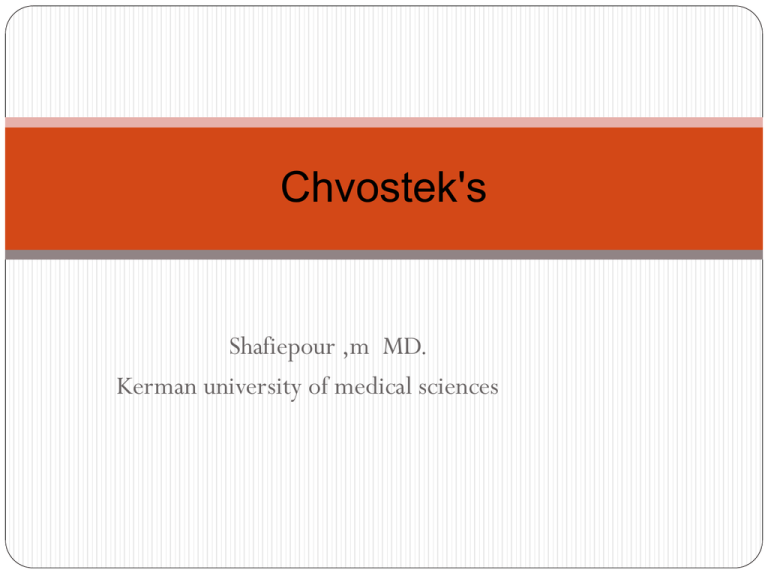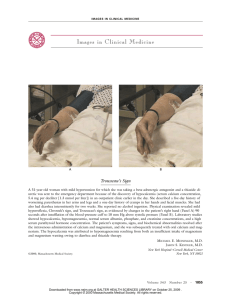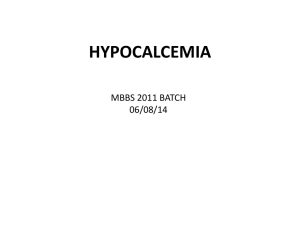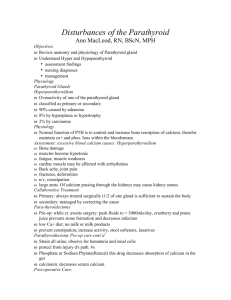Slide 1
advertisement

Chvostek's Shafiepour ,m MD. Kerman university of medical sciences 38-year-old man presented to the emergency Department with facial paresthesias and upperextremity muscle cramping. His symptoms were progressive, beginning as mild paresthesias on postoperative day 1; by the time he presented, they had been getting worse for about 24 hours. His medical history was noteworthy only for papillary thyroid carcinoma, for which he had undergone a total thyroidectomy 2 days earlier. Physical examination revealed apparent Chvostek’s sign and Trousseau’s sign and a result of postsurgical acquired hypoparathyroidism. On physical examination, a Chvostek's sign (twitching of the circumoral muscles in response to gentle tapping of the facial nerve just anterior to the ear) may be elicited, although it is also present in10% of normal individuals. Carpal spasm may be induced by inflation of a blood pressure cuff to 20 mmHg above the patient's systolic blood pressure for 3 min (Trousseau's sign). Severe hypocalcemia can induce seizures, carpopedal spasm, bronchospasm, laryngospasm, and prolongation of the QT interval. His total calcium level was 5.8 mg per deciliter (normal range, 8.4 to 10.3) (1.45 mmol per liter [2.1 to 2.6]), his free calcium level was 1.68 mEq per liter (normal range, 2.24 to 2.64) (0.84 mmol per liter [1.12 to 1.32]), and his serum phosphate level was 6.6 mg per deciliter (normal range, 2.7 to 4.5) (2.13 mmol per liter [0.87 to 1.45]). The parathyroid hormone level was 7 pg per milliliter (normal range, 15 to 65). Chvostek’s sign is described as the twitching of facial muscles in response to tapping over the area of the facial nerve. Trousseau’s sign is carpopedal spasm that results from ischemia, such as that induced by pressure applied to the upper arm from an inflated sphygmomanometer cuff Chvostek’s sign is neither sensitive nor specific for hypocalcemia, since it is absent in about one third of patients with hypocalcemia and is present in approximately 10% of persons with normal calcium levels. Trousseau’s sign, however, is more sensitive and specific; it is present in 94% of patients with hypocalcemia and in only 1% of persons with normal calcium levels. Our patient’s symptoms resolved with intravenous administration of calcium gluconate, and he was discharged with instructions to begin oral calcium supplementation and to maintain close follow-up with his endocrinologist. Acute, symptomatic hypocalcemia is initially managed with calcium gluconate, 10 mL 10% wt/vol (90 mg or 2.2 mmol) intravenously, diluted in 50 mL of 5% dextrose or 0.9% sodium chloride, given intravenously over 5 min. Continuing hypocalcemia often requires a constant intravenous infusion (typically 10 ampuls of calcium gluconate or 900 mg of calcium in 1 L of 5% dextrose or 0.9% sodium chloride administered over 24 h). Accompanying hypomagnesemia, if present, should be treated with appropriate magnesium supplementation. Chronic hypocalcemia due to Hypoparathyroidism is treated with calcium supplements (1000–1500 mg/d elemental calcium in divided doses) and either vitamin D2 or D3 (25,000–100,000 U daily) or calcitriol [1,25(OH)2D, 0.25–2 g/d]. Other vitamin D metabolites (dihydrotachysterol, alfacalcidiol) are now used less frequently.






